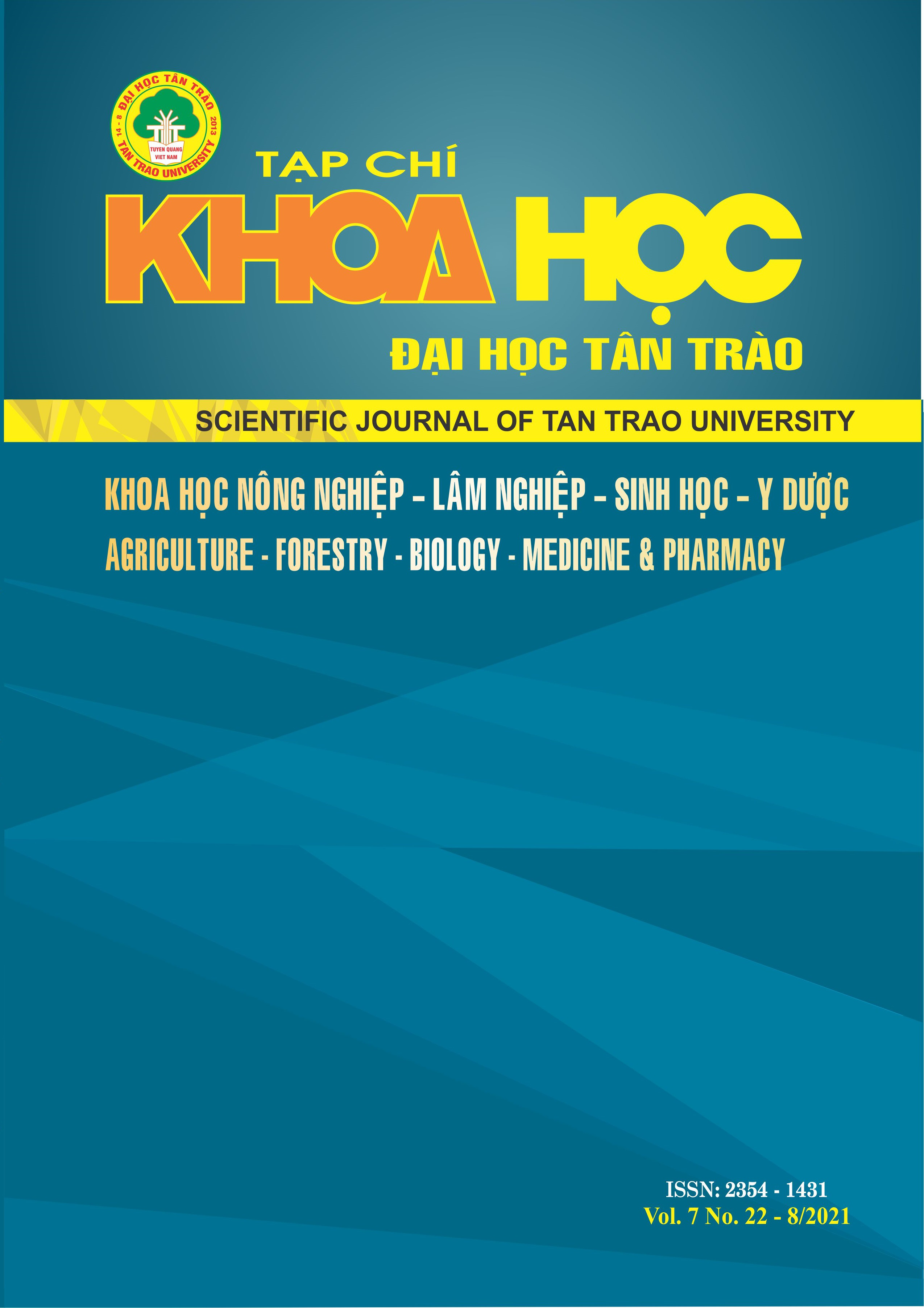NGHIÊN CỨU CHIẾT TÁCH TINH DẦU CÂY LÁ LỐT ĐỂ CHỮA BỆNH ĐAU XƯƠNG KHỚP
DOI:
https://doi.org/10.51453/2354-1431/2021/576Từ khóa:
Cây lá lốt, tách chiết, tinh dầu, chÆ°ng cất, nồng Ä‘á»™ dung môi.Tóm tắt
Cây lá lốt có tên khoa học là Piper sarmentosum là loài đặc hữu phổ biến ở các nước Việt Nam, Lào, Campuchia. Tinh dầu lá lốt chứa nhiều thành phần có công dụng chữa bệnh đau xương khớp. Cây lá lốt được hái ở khoa CNSH- CNTP trường ĐH Nông lâm Thái Nguyên được phơi khô và cắt lát cất nhỏ. Thí nghiệm tách chiết tinh dầu lá lốt sử dụng phương pháp chưng cất lôi cuốn hơi nước với các nội dung cho kết quả như sau: Tìm ra được dung môi thích hợp cho quá trình tách chiết tinh dầu lá lốt là: NaCl cho hiệu suất trích ly cao là 88%, nồng độ dung môi thích hợp là 2% với hàm lượng tinh dầu sẽ thu được là 0,790% , thời gian là 3 giờ. Tìm ra được tỉ lệ dung môi/nguyên liệu là 300/1 và thu được hàm lượng tinh dầu là 0,820%.
Tải xuống
Tài liệu tham khảo
[1] Dien, V. V., Vui, D. T., Tinh, H. (2004). Contributing to research on the chemistry and biological effects of Herba Piperis Lolot. Pharmacology, No. 10 (8-10) in the pepper family (PIPERACEAE) in North Central. Hanoi Academy of Science and Technology, Vietnam.
[2] Hieu, L. D. (2017). Research on some biological characteristics, distribution and chemical composition of essential oils of species in the pepper family (Piperaceae) in North Central Vietnam, Vietnam.
[3] Thuy, T. X. Contributing to research on chemical composition of guise leaves (Piper lolot C.DC). Master Thesis, Vietnam.
[4] Tinh, T. D. X. (2014). Research on extraction and determination of chemical composition in guise leaf extract in Hoa Vang district. University of Da Nang, University of Pedagogy, Faculty of Chemistry, Vietnam.
[5] Chaveerach, A., Mokkamul, P., Sudmoon, R., Tanee, T. (2008). Ethnobotany of the genus Piper (Piperaceae) in Thailand. Ethnobot Res Appl, 4: 223–231.
[6] Perry, L. M. (1981). Medicinal plants of East and Southeast Asia. Cambridge: MIT Press.
[7] Duke, J. A., Ayensu, E. S. (1985). Medicinal Plants of China. Algonac, USA: Reference Publications Inc.
[8] Toong, V. Y., Wong, B. L. (1989). Phytochemistry of medicinal plants Piper sarmentosum. Kuala Lumpur: Traditional Medicine, Institute of Advance Studies, University of Malaya.
[9] Ong, H., Norzalina, J. (1999). Malay herbal medicine in Gemencheh, Negri Sembilan, Malaysia. Fitoterapia, 70, 10–14. [Crossref], [Web of Science ®],
Tải xuống
Đã Xuất bản
Cách trích dẫn
Số
Chuyên mục
Giấy phép

Tác phẩm này được cấp phép theo Giấy phép Quốc tế Creative Commons Attribution-ShareAlike 4.0 .
Bài báo được xuất bản ở Tạp chí Khoa học Đại học Tân Trào được cấp phép theo giấy phép Ghi công - Chia sẻ tương tự 4.0 Quốc tế (CC BY-SA). Theo đó, các tác giả khác có thể sao chép, chuyển đổi hay phân phối lại các bài báo này với mục đích hợp pháp trên mọi phương tiện, với điều kiện họ trích dẫn tác giả, Tạp chí Khoa học Đại học Tân Trào và đường link đến bản quyền; nêu rõ các thay đổi đã thực hiện và các nghiên cứu đăng lại được tiến hành theo cùng một bản quyền.
Bản quyền bài báo thuộc về các tác giả, không hạn chế số lượng. Tạp chí Khoa học Tân Trào được cấp giấy phép không độc quyền để xuất bản bài báo với tư cách nhà xuất bản nguồn, kèm theo quyền thương mại để in các bài báo cung cấp cho các thư viện và cá nhân.
Mặc dù các điều khoản của giấy phép CC BY-SA không dành cho các tác giả (với tư cách là người giữ bản quyền của bài báo, họ không bị hạn chế về quyền hạn), khi gửi bài tới Tạp chí Khoa học Đại học Tân Trào, tác giả cần đáp ứng quyền của độc giả, và cần cấp quyền cho bên thứ 3 sử dụng bài báo của họ trong phạm vi của giấy phép.






